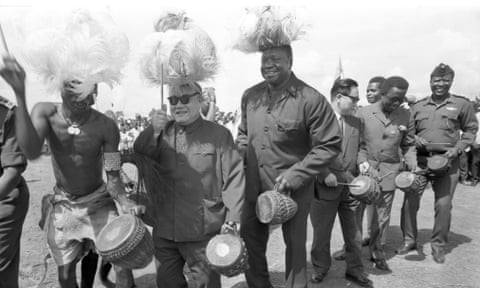For decades he has been reviled as a simple-minded and sadistic dictator, or lampooned as a clownish thug.
Now tens of thousands of newly discovered images have shown how Idi Amin exploited cutting-edge media technology, populism and radical ideologies to maintain his bloody grip on power in the 1970s.
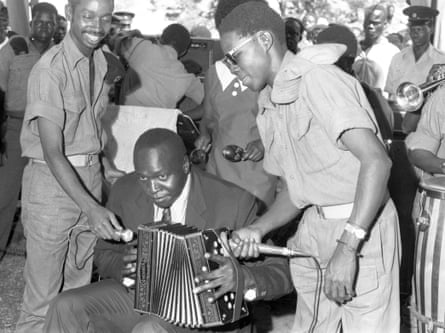
Most of the 70,000 pictures were taken by a team of photographers from the information ministry who followed the Ugandan dictator over the course of his eight-year rule. Many show Amin at public occasions, but some are of private episodes, such as the arrest and humiliation of alleged petty criminals shortly before their execution.
Others are more intimate, showing the dictator with his family or close associates, and were taken by officials and associates. Amin is seen with his children surrounded by Christmas decorations, playing the accordion and swimming.

Historians say the images, found in a locked filing cabinet at the Ugandan state broadcaster’s offices by archivists four years ago but only now given a public view, provide extraordinary new insights into Amin and the nature of his regime, which was one of the worst in post-colonial Africa. They also cast new light on the reality of life for ordinary Ugandans under the rule of a man held responsible for between 100,000 and 500,000 deaths.

Rose Mwanja Nkaale, the commissioner of the government’s museums and monuments department, said she had been surprised to see images of a “jovial character who was very social with the common people”.
“It made me wonder what turned him into what he became. He started well but turned into something else. We need to learn about what we must fight against to stop these things ever happening again,” Nkaale said.

During Amin’s rule, security services and the military targeted different ethnic communities seen as potentially disloyal, as well as real and imagined opponents. Journalists, judges, businesspeople, artists, officials and clerics were abducted, tortured and killed. Victims included Uganda’s Anglican archbishop and one of Amin’s own wives.
Dr Richard Vokes, an anthropologist at the University of Western Australia, who was involved in the discovery, said the photographs depicted a “kind of manic energy” that was both “behind the brutality and part of the brutality”.
“We see how [Amin] embraced the media and understood its power ... How he had a great sense of how media could amplify his ego and his political will,” Vokes said.
The display of a selection of the pictures at Uganda’s national museum in a pioneering exhibition has been welcomed by many of Amin’s relatives, as well as the families of some of his victims.
Sarah Bananuka, whose father and three brothers were murdered during Amin’s rule, said the exhibition was a good initiative but expressed concern that the official photographs might hide the grim reality of the regime.
“In these pictures you see him in parties, enjoying life and meeting people. We didn’t see the other side of Amin, which we felt, lived and experienced,” the 69-year-old said.
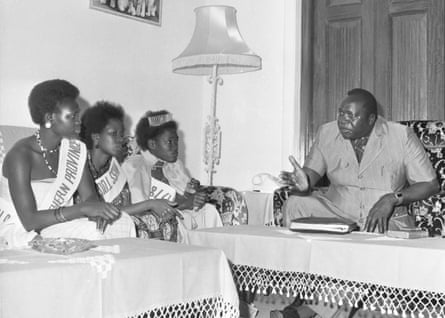
Hajji Edrisa Mayanja Njuki, the head of the presidential press unit during the 1970s, said the exhibition depicted the “real Amin”. “The pictures that show his good side had never been produced and published. It has always been the negative side of the story,” Njuki said.
Unlike in South Africa after the fall of the apartheid regime, or in Rwanda after the genocide of 1994, there has been no official attempt in Uganda to address the violence that followed Amin’s seizure of power in 1971.
“[Uganda] has never had a process of mourning, even of reflection. There are no public memorials, victims’ groups … all the things you see elsewhere in places with traumatic periods in their past. So this is the first public memorial,” Vokes said.
The exhibition’s organisers had to wrestle with the fact that few of the photographs depict the violence of life in Uganda in the 1970s.
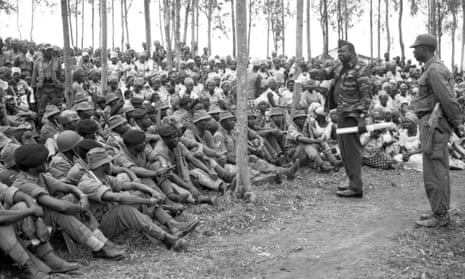
“As curators, we have made efforts throughout this exhibition to remind the viewer that for many Ugandans the 1970s were a perilous time,” said Derek Peterson, a historian at the University of Michigan, who is working to preserve endangered government archives in Uganda. “The photos are so overwhelmingly positive in their appraisal of Amin that we’ve really had to work to find ways to bring the violence of the time into focus.”
One strategy was to feature images of Amin’s victims, as well as pictures taken immediately after his fall of torture chambers used by his feared security services.
So extensive was the violence under Amin that state photographers themselves were at risk. One was executed after taking pictures of the aftermath of a hijacking by Palestinian and German terrorists that led to a raid by Israeli special forces on Entebbe airport in 1976.
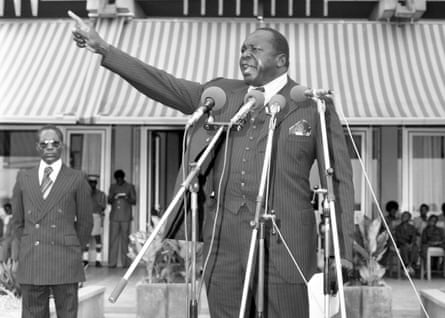
Peterson said the images underlined the breadth of Amin’s relations with radical leftist organisations and regimes across Africa, the Middle East and beyond. There are photos of representatives from the Palestinian Liberation Organisation meeting the dictator, and pictures of a deputation of black activists from the US.
British and other officials expected Amin to choose the west in the cold war battle for influence under way across Africa at the time. Instead, he took Uganda into the “revolutionary international” group of what were then known as “progressive” states, receiving wide-ranging support from Libya’s Muammar Gaddafi and arms from the Soviet Union. East Germany assisted Amin’s security services.
Amin was ousted after launching an invasion of Tanzania in 1979 and died in exile in Saudi Arabia in 2003.
Bananuka said the exhibition was “a beginning”. “It’s making people come out to think how we can do it better. We need to get more people who are willing to talk about their experiences and share it out. Maybe somebody may learn a lesson or two,” she said.
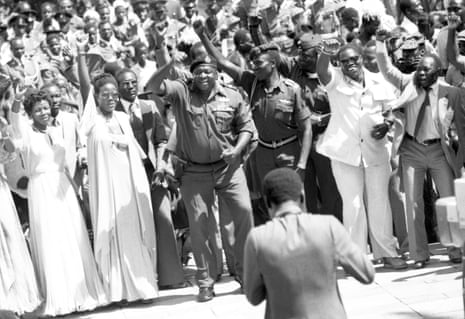
Jaffar Remo Amin, the third son of the dictator, said he hoped it would bring the country together. “The country has never settled and united as one. That fracture will be permanent if we don’t discuss our past and go through healing. The country needs a lot of healing,” the 53-year-old said.
Additional reporting by Samuel Okiror in Kampala
